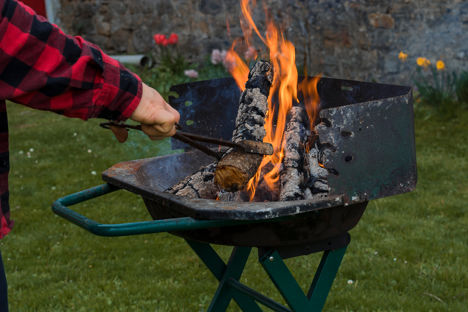Our obsession with barbecue is an interesting one. We have ovens, grills and hobs indoors that cook our food efficiently and to exact temperatures at the simple turn of a dial, so why do we still feel the need to cook outdoors? Well, barbecue is about more than eating. It’s about great food cooked with a lick of fire and smoke, and time enjoyed in the great outdoors with family and friends. When was the last time you invited people over to enjoy the delights coming from your microwave?
If it’s summer and you want a gathering, most people will rightly get excited by the prospect of you firing up the barbecue. You may not believe it, but Brits have always been experts in cooking over open fire – for centuries we barbecued large chunks of meat in open hearths, whilst wood-fired bread ovens sat at the heart of our bakeries. Those heady days fell by the wayside in the '70s and '80s, but now there are more and more people taking up barbecue as a serious hobby – or even as a profession – and as a result we’re reigniting our passion for open-fire cooking.
In many ways, barbecue connects us with our primitive roots. Cooking with smoke links us with the practices of our primordial ancestors, and the act of gathering around fire and eating together is ancient and intrinsically human. Pretty much all cultures cook with smoke, from gentle wisps of herb and pine smoke in northern regions, to deep, rich wood smokes like hickory and mesquite in the American Deep South. Aside from the obvious link between fire and cooking, there’s a reason why various cultures cook with smoke specifically – the flavour and aroma of smoke adds unique depth and richness to food, and different woods give very different results.
As for the science, it’s not quite as simple as smoking food and ending up with a smoky flavour at the end of it. Fat molecules take on the smoke flavour far more efficiently than any other, and the oils then draw the flavour deep within the food. Think about your typical smoked foods and you’ll see that they all have one thing in common – fat. Pork shoulders, bellies and ribs, beef brisket, fatty fish like salmon and mackerel are all perfect for smoking.
Setting up for smoking
To set up a regular kettle barbecue for hot-smoking, you’ll need to set it up for indirect cooking – click here for more on how to set up your barbecue for direct and indirect cooking. Light a small pile of coals and keep them to one side – these will be your indirect heat source, and you can put your smoking wood of choice on top to create your smoke. You’re looking for a temperature of 80-100ºC for hot-smoking delicate foods like salmon, and go for a slightly hotter 110-120ºC when you’re hot-smoking meats to ensure they are cooked through. You control the levels of heat and smoke with the amount of coals you have burning, the airflow powering the coals and the amount of wood you have on the coals to smoke – more coals and airflow will mean more heat, and vice versa. Be careful with regards to your temperature – gentle smoke is always best, and pumping up the heat will give you acrid smoke, which can make your food taste like an ashtray.
Smoking woods fall into three main groups: hardwoods such as oak, beech and birch; fruit woods such as cherry, apple and pear and nut woods such as hazel and pecan. They all have wonderful unique characters that are worth exploring, such as the lovely toasty vanilla smokiness you get from oak, and the bacon-like nature of hickory. It’s great to experiment with smoke and make your own blends – for example I love hickory and cherry mixed together for chicken and pork. You can also add extra elements such as herbs – rosemary, bay and thyme are all fantastic smouldering away, but be careful as they’re quite strong flavours and should be used sparingly.
Ultimately, think subtle and you will end up with great results. Think about the size of the pieces of wood – dust will vanish quickly in a puff of smoke, and chips will burn quickly (although soaking them in water for half an hour before using means they'll last a little longer). I find the best size is a chunk of wood that you can fit in your closed hand. Place this on the charcoal or above the burners on a gas barbecue and you will get a lovely gently smouldering smoke.
Get in touch
Please sign in or register to send a comment to Great British Chefs.


